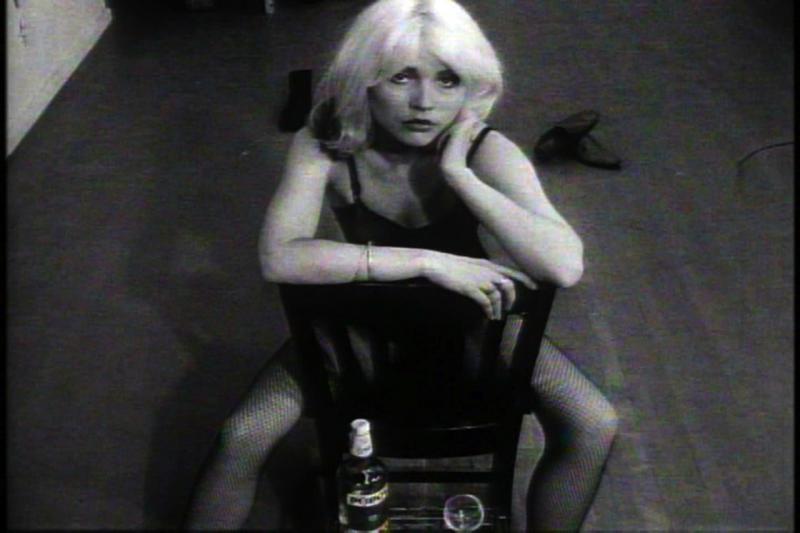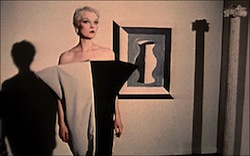Blank City | reviews, news & interviews
Blank City
Blank City
A ramshackle oral history of Downtown Manhattan's post-punk No Wave cinema

Céline Danhier’s Blank City is a useful but slightly frustrating primer on the grass-roots No Wave cinema movement that blossomed in New York’s East Village and Lower East Side in the post-punk era of the late Seventies and early Eighties.
Danhier got terrific access to onscreen luminaries like Lydia Lunch, Deborah Harry, Ann Magnuson, Steve Buscemi, Patti Astor (pictured below in Eric Mitchell's Underground USA), John Lurie, and Thurston Moore, and such filmmakers as Mitchell, Amos Poe (who kickstarted No Wave with his 1976 punk movie The Blank Generation), Lizzie Borden, Becky Johnston, Betty Gordon, James Nares, Jim Jarmusch, Sara Driver, Scott B, Beth B, John Waters, Vivienne Dick, and Susan Seidelman.
 Sometimes funny, always nihilistic, No Wave eventually morphed into the satirical shock-heavy Cinema of Transgression fostered by Nick Zedd (its manifesto-writer), Richard Kern, and star and arch-provocatrix Lunch before declining during the eras of Reaganomics, MTV, and AIDs. It was around long enough to forge a link between the countercultural cinema of the Sixties and the independent movement that began in earnest in 1986.
Sometimes funny, always nihilistic, No Wave eventually morphed into the satirical shock-heavy Cinema of Transgression fostered by Nick Zedd (its manifesto-writer), Richard Kern, and star and arch-provocatrix Lunch before declining during the eras of Reaganomics, MTV, and AIDs. It was around long enough to forge a link between the countercultural cinema of the Sixties and the independent movement that began in earnest in 1986.
This is one of those movies whose audience is pre-determined. Copious clips from such rigorously unpolished landmarks as Poe’s Unmade Beds and The Foreigner, Mitchell’s Kidnapped, Gordon’s Empty Suitcases, Borden’s Born in Flames (its World Trade Center terrorism theme bizarrely prophetic), Zedd's They Eat Scum, Jarmusch’s Permanent Vacation, and Kern’s video for Sonic Youth’s “Death Valley ’69” will not impress anyone with an interest in production values or necessarily convert the unconverted. It’s worth noting that the majority of these films were not made for mass audiences but for friends and fellow scenesters.
Although Blank City bring up such crucial precursors as Jonas Mekas, Jack Smith, Shirley Clarke, and Robert Frank, first-time director Danhier is less interested in placing No Wave in firm historical or aesthetic contexts than in capturing the almost desperate energy with which the No Wave filmmakers seized their moment. Nares offers a little evolutionary history, however, when he observes how No Wave filmmakers “took from underground and experimental cinema to make a darker cinema reflective of darker times”.
The director Michael Oblowitz admits his values went out the window when he partied with celebs like John Belushi
Judging by the rooms where they were recorded, some of the interviewees appear to have heeded the call of upward mobility, though that is human nature. By the same token, the rat-and-roach-infested, rubble-strewn neighbourhoods that provided a backdrop to many of the films have been gentrified, a trend initiated by Mayor Ed Koch that helped suck the life from No Wave. Casandra Stark (Mele), who directed two of the most lyrical No Wave films, recalls how she was brutally evicted from her building when it was needed for redevelopment.
The anecdotes reveal the extent to which the filmmakers’ vérité, home-movie style efforts were made on minuscule budgets, often with the help of crime. Lurie manufactured a robbery at his apartment to finance a film from the insurance payout. Mitchell stole electricity from his neighbour Lurie’s apartment. Ex-groupie Lunch says she was inspired less by fellow artists and musicians than by the people “I was trying to bamboozle or trick or rip off or hustle”.
Nares explains how, pretending to be interested in renting an opulent apartment, he surreptitiously undid a window catch, breaking in that night with his actors and camera to film part of his high-camp Roma ’78 there. Some of the filmmakers lived in virtual poverty. At the time Poe made Unmade Beds, he was living on welfare and taking care of his and his wife’s newborn because the wife was in a mental hospital. It was, he recalls, the best of times and the worst of times.
They couldn’t last. The media ruinously discovered New York's hitherto self-contained boho culture, leading to its crass commodification, while fame and riches beckoned some. The director Michael Oblowitz admits his values went out the window when he partied with celebrities like John Belushi.
Lurie says he hates “to this day” Jean-Michel Basquiat, the late artist (featured in Downtown 81), who went from sleeping on Lurie’s floor to espousing the coolness of wealth: “That attitude ruined a lot of things.” A happier epitaph to Blank City is provided by Nares when he thoughtfully remarks that the renegade films made by himself and his colleagues “had some kind of integrity that went beyond appearance”.
Below: a clip from Blank City
The future of Arts Journalism
You can stop theartsdesk.com closing!
We urgently need financing to survive. Our fundraising drive has thus far raised £49,000 but we need to reach £100,000 or we will be forced to close. Please contribute here: https://gofund.me/c3f6033d
And if you can forward this information to anyone who might assist, we’d be grateful.

Subscribe to theartsdesk.com
Thank you for continuing to read our work on theartsdesk.com. For unlimited access to every article in its entirety, including our archive of more than 15,000 pieces, we're asking for £5 per month or £40 per year. We feel it's a very good deal, and hope you do too.
To take a subscription now simply click here.
And if you're looking for that extra gift for a friend or family member, why not treat them to a theartsdesk.com gift subscription?
more Film
 Urchin review - superb homeless drama
Frank Dillane gives a star-making turn in Harris Dickinson’s impressive directorial debut
Urchin review - superb homeless drama
Frank Dillane gives a star-making turn in Harris Dickinson’s impressive directorial debut
 Mr Blake at Your Service review - John Malkovich in unlikely role as an English butler
Weird comedy directed by novelist Gilles Legardinier
Mr Blake at Your Service review - John Malkovich in unlikely role as an English butler
Weird comedy directed by novelist Gilles Legardinier
 Don't Let's Go to the Dogs Tonight review - vivid adaptation of a memoir about a Rhodesian childhood
Embeth Davidtz delivers an impressive directing debut and an exceptional child star
Don't Let's Go to the Dogs Tonight review - vivid adaptation of a memoir about a Rhodesian childhood
Embeth Davidtz delivers an impressive directing debut and an exceptional child star
 One Battle After Another review - Paul Thomas Anderson satirises America's culture wars
Leonardo DiCaprio, Teyana Taylor, and Sean Penn star in a rollercoasting political thriller
One Battle After Another review - Paul Thomas Anderson satirises America's culture wars
Leonardo DiCaprio, Teyana Taylor, and Sean Penn star in a rollercoasting political thriller
 Steve review - educator in crisis
Cillian Murphy excels as a troubled headmaster working with delinquent boys
Steve review - educator in crisis
Cillian Murphy excels as a troubled headmaster working with delinquent boys
 Can I get a Witness? review - time to die before you get old
Ann Marie Fleming directs Sandra Oh in dystopian fantasy that fails to ignite
Can I get a Witness? review - time to die before you get old
Ann Marie Fleming directs Sandra Oh in dystopian fantasy that fails to ignite
 Happyend review - the kids are never alright
In this futuristic blackboard jungle everything is a bit too manicured
Happyend review - the kids are never alright
In this futuristic blackboard jungle everything is a bit too manicured
 Robert Redford (1936-2025)
The star was more admired within the screen trade than by the critics
Robert Redford (1936-2025)
The star was more admired within the screen trade than by the critics
 Blu-ray: The Sons of Great Bear
DEFA's first 'Red Western': a revisionist take on colonial expansion
Blu-ray: The Sons of Great Bear
DEFA's first 'Red Western': a revisionist take on colonial expansion
 Spinal Tap II: The End Continues review - comedy rock band fails to revive past glories
Belated satirical sequel runs out of gas
Spinal Tap II: The End Continues review - comedy rock band fails to revive past glories
Belated satirical sequel runs out of gas

Add comment